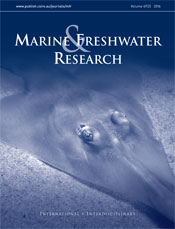Marine and Freshwater Research
Volume 67
Number 2 2016
Few studies have characterised the carbonate chemistry of nearshore coastal zones. Over multiple timescales, we measured the pH and calculated the pCO2 of an area dominated by seagrass beds (Saint Joseph Bay, Florida). Our results indicate that diel fluctuations should be considered when designing ocean acidification experiments and that coastal species are experiencing far greater fluctuations in carbonate chemistry than previously thought.
Phosphorus is vulnerable to the artificial lake, and sensitive to aquatic ecosystems. Phosphorus dynamics in a huge reservoir should be well documented, and the Three Gorges Reservoir exerts important influence on phosphorus speciation and transport. This study will improve our understanding of the mechanisms and processes responsible for the effect of artificial lake with a unique gradual mode of impoundment.
Interspecific variation in the elasmobranch electrosensory system remains poorly understood and as a result the functional consequences of such variation are unknown. Here, we directly tested the electrosensitivity of two benthic elasmobranchs that share a similar habitat and diet, but differ significantly in their electrosensory system morphology. The results suggest that differences in abundance and distribution of electrosensory pores have little to no effect on the absolute electrical sensitivity, and instead, may reflect species-specific differences in the spatial resolution and directionality of electroreception.
Observed levels of ultraviolet B (UVB) radiation off central Chile (36°S, 73°W) indicate that planktonic fish embryos from anchoveta (Engraulis ringens) and common sardine (Strangomera bentincki) were exposed to harmful UVB radiation levels, which in the field can cause a decrease in hatching success, embryonic malformations and changes in buoyancy.
Water-plant distribution is determined (in part) by water regime and salinity, so we can infer historical water regime and salinity from historical plant distribution. It was found that there were more records of drought-and salinity-tolerant plants along the Angas River and Tookayerta Creek in present-day surveys than in the past. Plant distribution, coupled with a knowledge of plant ecological requirements, can be informative about environmental conditions.
Otolith chemistry analyses coupled with a strong latitudinal age gradient in the south-east Australian Arripis trutta population indicate that most fish originate in southern NSW, Victoria and Tasmania and move progressively northward with increasing age. Some recruitment occurs in northern NSW but these fish may not mix with immigrants from further south until they are more than 5 years old.
This study was conducted in three salterns, with the goal to evaluate the diversity partitioning of phytoplankton along the saline gradient. At higher scales, the highest species richness was found between salt marshes; however, there was lower diversity and a decrease in similarity from the lower to the higher scale.
Sponges on coral reefs generally grow on large pieces of rock or on smaller rubble pieces that are more easily moved by water flow. Investigating the interaction of substrate stability and water flow, this study found that sponges were most abundant and grew largest on rock, particularly at shallow depths where flow rates are highest. Natural and man-made factors that change substrate composition of coral reefs will affect numbers and sizes of sponges.
This study explored the distribution of an uncommon soft coral species (Dendronephthya australis) within the Port Stephens–Great Lakes Marine Park. D. australis colonies occurred along the southern shoreline in the Port Stephens estuary, but no colonies were found within marine park sanctuary (no-take) zones. Owing to its current threats, implications from this study will assist future management, particularly in regard to its protection within a marine park.
Overfishing has led to the collapse of many marine fish stocks. In this study, genetic markers were utilised to investigate population structure and genetic relatedness in an overfished South African fish species, the dusky kob. Results showed low genetic structuring and declining population trends, which should be taken into account for future management and conservation of depleted dusky kob populations.




